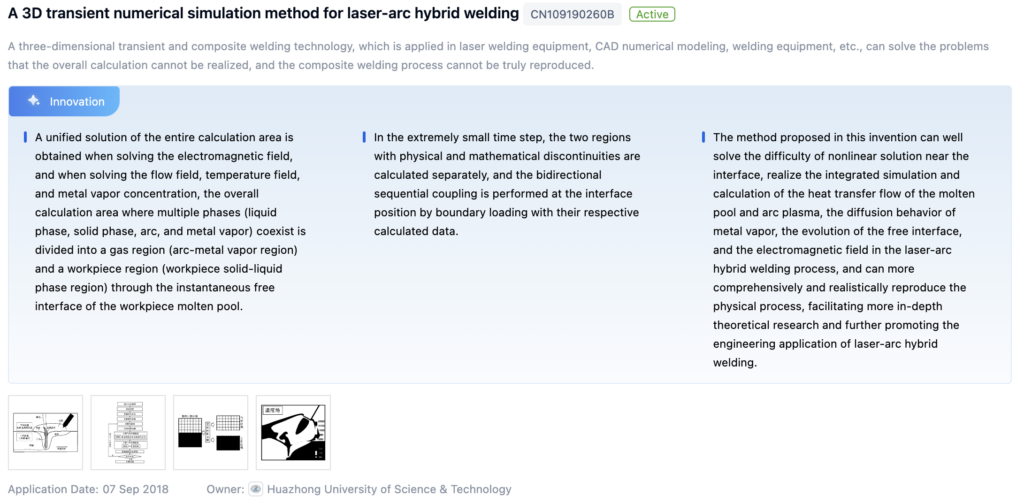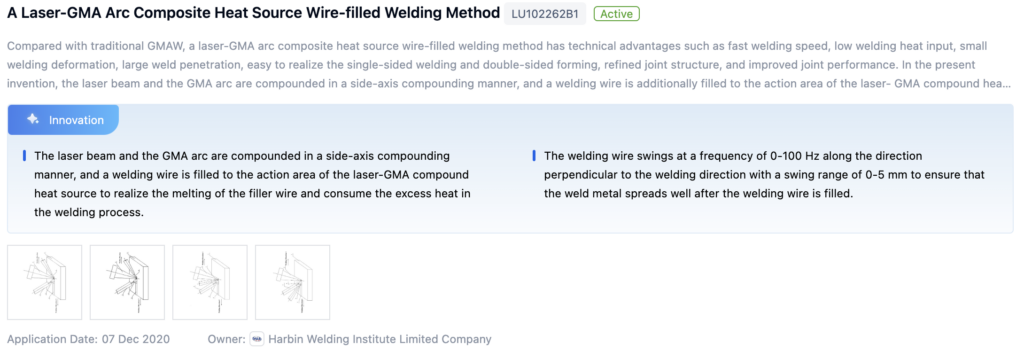
Technical Background and Objectives
Background
Welding is essential across various industries including construction, manufacturing, and transportation. Ensuring good welding performance is crucial for structural integrity, safety, and reliability. Patent applications related to good welding performance have consistently increased, suggesting ongoing research and innovation. However, literature publications show fluctuating interest, indicating stable academic research with varying focus over the years. This trend highlights the industry’s drive for patentable innovations, while academic research provides foundational support.

Objectives
The primary objective is to develop advanced welding techniques and methodologies to consistently deliver superior welding performance. Leveraging cutting-edge technologies, the aim is to enhance weld quality, strength, and reliability across various applications. The ultimate goal is to provide practical solutions to improve productivity, reduce costs, and ensure the safety and durability of welded structures.
To get a detailed scientific explanations of Good Welding Performance, try Eureka.
Technical Current Status Analysis
Industry Overview
Welding is critical in construction, automotive, aerospace, and energy sectors. High-quality welding is vital for building strong structures, ensuring safety, and preventing failures.
Applications and Impact:
- Construction: Essential for building bridges, skyscrapers, and pipelines.
- Automotive: Crucial in manufacturing vehicle bodies, frames, and components.
- Aerospace: Key for producing aircraft components where defects can have catastrophic consequences.
- Energy: Used in fabricating power plants, pipelines, and offshore platforms, critical for preventing leaks and accidents.
Technical Characteristics and Challenges:
- Weld Quality: Achieving high-quality welds with minimal defects like porosity and cracks.
- Mechanical Properties: Ensuring welded joints have adequate strength, toughness, and ductility.
- Metallurgical Aspects: Controlling microstructural changes and phase transformations during welding.
- Process Control and Automation: Maintaining consistent welding processes, especially in manual operations.
- Dissimilar Material Welding: Addressing challenges in joining materials with different properties.
- Environmental Factors: Overcoming challenges in harsh environments like extreme temperatures or underwater.
Technological Paths:
- Advanced Welding Processes: Techniques like friction stir welding, laser beam welding, and electron beam welding.
- Computational Modeling and Simulation: Optimizing welding parameters and predicting microstructural changes.
- Intelligent Process Control and Automation: Using adaptive control, machine learning, and real-time monitoring.
- Advanced Materials and Consumables: Developing high-strength alloys and specialized filler materials.
- Non-Destructive Testing and Inspection: Using ultrasonic testing, radiography, and phased array ultrasonic testing.
- Specialized Welding Techniques: Techniques for dissimilar materials, underwater welding, and extreme environments.

Research Content
Research Objectives
Develop advanced welding techniques and methodologies to enhance the quality, strength, and reliability of welded joints across various applications.
Research Direction and Focus
Materials and Alloy Characterization
- Study behavior and properties of different materials under various welding conditions.
- Analyze microstructural changes, phase transformations, and mechanical properties.
- Develop tailored welding techniques and parameter optimization strategies.
Advanced Welding Processes and Techniques
- Explore friction stir welding, laser beam welding, and hybrid welding methods.
- Investigate automation, robotics, and intelligent control systems for consistent welding performance.
Weld Integrity and Defect Analysis
- Develop non-destructive testing (NDT) methods and computational modeling techniques.
- Detect and characterize defects like porosity and cracks to optimize welding parameters.
Computational Modeling and Simulation
- Develop and validate models to predict and optimize welding processes.
- Simulate heat transfer, fluid flow, and microstructural evolution for improved welding performance.
Environmental and Economic Considerations
- Investigate strategies to reduce energy consumption and emissions.
- Explore sustainable materials and practices, and conduct cost-benefit analyses for industrial adoption.
Technical Development Roadmap
Key Areas of Advancement
- Arc Welding Process Technologies: Advanced pulsed GMAW/FCAW, narrow groove FCAW, and tandem wire feeding GMAW.
- Welding Automation and Robotics: Adaptive robotic welding, machine vision for seam tracking, and collaborative robotic welding cells.
- Advanced Welding Materials and Consumables: High-strength low-alloy consumables, dissimilar metal welding techniques, and additive manufacturing welding wire.

Main Player Analysis
Key Players and Focus
- Matsushita Electronics Corp.: 5170 patents on arc welding, resistance welding, and laser welding focusing on weld quality and efficiency.
- Beijing University of Technology: 41 publications on laser welding, friction stir welding, dissimilar material joining, and microstructural analysis.
- Harbin Institute of Technology: 41 publications on dissimilar material joining, mechanical property evaluation, and process optimization.
- NIPPON STEEL CORP.: 5346 patents on welding processes for steel and other metals, focusing on quality and efficiency.
- Daiichi Shokai Co. Ltd.: 3943 patents on welding processes, focusing on weld parameter optimization, joint design, and process control systems.
Current Technical Solution Overview
Welding Methods for Improved Quality
- Quality Monitoring and Assessment: Techniques for real-time monitoring and post-weld inspections.
- Parameter Optimization: Optimizing heat input, travel speed, and shielding gas composition.
- Quality Prediction and Modeling: Computational models to predict and optimize weld quality.
- Post-Weld Treatments: Heat treatments and mechanical processes to enhance weld properties.
- Hybrid Welding Techniques: Combining processes for improved weld quality.
Welding Wire and Electrode Compositions
- Compositions for Improved Properties: Alloying elements to enhance weld strength and toughness.
- Coatings and Treatments: Surface treatments to improve arc stability and reduce spatter.
- Designs for Productivity: Cored wires and metal-cored wires for increased deposition rates.
- Feeding Systems: Mechanisms for consistent wire delivery.
- Specialized Electrodes: Tailored for specific materials and applications.
Monitoring and Control Systems
- Quality Monitoring: Systems to assess weld pool temperature, arc voltage, and current.
- Control and Feedback: Real-time adjustments based on monitored data.
- Assessment and Inspection: Techniques for evaluating completed welds.
- Process-Specific Monitoring: Systems tailored for resistance welding, laser welding, or friction stir welding.
- Training and Skill Assessment: Systems for analyzing welding techniques and providing feedback.
Welding Fixtures and Support Structures
- Clamping Mechanisms: Fixtures for positioning and securing workpieces.
- Rotary Fixtures: For circumferential welding of cylindrical components.
- Adjustable and Modular Fixtures: Versatile fixtures for different applications.
- Cooling Systems: Fixtures with integrated cooling for heat management.
- Positioning and Alignment Features: Ensuring precise workpiece alignment.
Post-Weld Treatments
- Heat Treatment Processes: Enhancing properties through specific heating cycles.
- Localized Treatments: Targeted heating for specific areas.
- Material-Specific Treatments: Tailored processes for different materials.
- Monitoring and Control: Systems for consistent heat treatment conditions.
- Integrated Processes: Combining welding and post-weld heat treatment.
Key Patent Interpretation
Patent Highlights
Patent 1: 3D Transient Numerical Simulation Method for Laser-Arc Hybrid Welding
- Core Invention Points:
- Solves the electromagnetic field and flow field, temperature field, and metal vapor concentration.
- Divides the calculation area into gas and workpiece regions.
- Realizes integrated simulation of heat transfer, flow, and arc plasma behavior.

Patent 2: Nanoparticle Composite Welding Filler Materials
- Core Invention Points:
- Comprises functionalized metal-containing powder with nanoparticles.
- Provides uniform distribution of reinforcement nanoparticles.

Patent 3: Laser-GMA Arc Composite Heat Source Wire-Filled Welding Method
- Core Invention Points:
- Combines laser beam and GMA arc with filler wire for melting.
- Improves welding deposition efficiency and reduces deformation.

Possible Research Directions
- Weld Quality Monitoring and Control: Real-time monitoring and feedback control for parameter adjustments.
- Welding Process Optimization: Techniques for optimizing design, sequence, and parameters.
- Welding Fixtures and Support: Devices for improving weld performance and facilitating operations.
- Welding Consumables and Materials: Developing advanced wires, electrodes, and shielding gases.
- Post-Weld Heat Treatment: Methods to enhance weld properties and performance.
If you want an in-depth research or a technical report, you can always get what you want in Eureka Technical Research. Try now!

